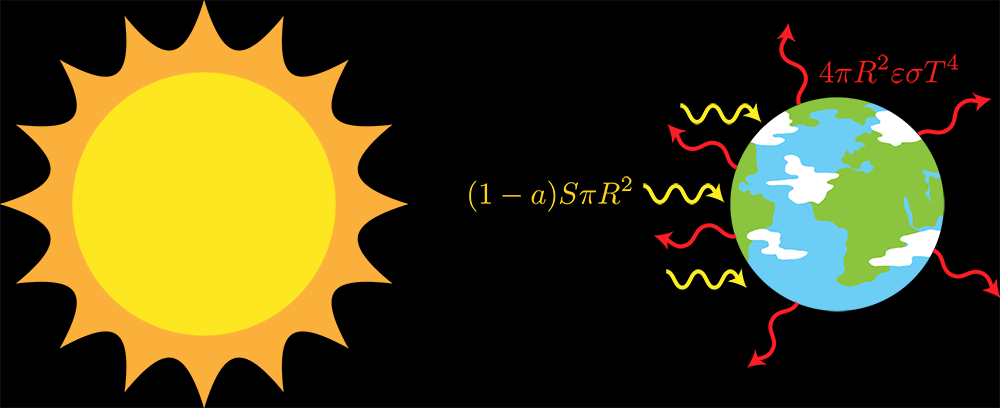Example (Earth)
Input solar constant: 1361
Input albedo: 0.306
Input emissivity: 0.612
Output rock temperature: 14.059374
In this first problem on climate modeling we'll look at the simplest possible climate model of the Earth and use it
to calculate Earth's temperature.
It's a zero-dimensional energy balance model where we'll assume that the energy absorbed by the
Earth is equal to the energy being radiated out by the Earth. We can call this balanced state
radiative equilibrium where
$$ \text{Energy in} = \text{Energy out} $$
We can call this model the rock-star model because we have a star that's heating up a rocky planet. The
planet has no atmosphere, it's just a rock floating through space. We can use it to calculate the Earth's average
temperature.

The solar power hitting the top of the atmosphere is given by the
solar constant $S = 1361 \; \mathrm{W/m}^2$. It's
very high at the top of the atmosphere but a lot of it gets absorbed by the atmosphere, especially by clouds, so the
solar power hitting the Earth's surface is lower than $S$.
The sun shines on only half of the Earth at a time so all that solar power is incident on a circular area $\pi R^2$
where $R$ = 6371 km is the radius of the Earth. So the total solar energy reaching the Earth is $S\pi R^2$.
But some of the solar energy is reflected back to space by stuff like clouds, snow, and sand. The fraction reflected
back is called the albedo $a$ which is between 0 (everything is
absorbed) and 1 (everything is reflected). Clouds and snow have a pretty high albedo while forests and the ocean have
a pretty low albedo, but on average Earth's albedo is $a \approx 0.306$.
So the total energy absorbed by the Earth is
$$ \text{Energy in} = (1 - a) S \pi R^2 $$
We can treat the Earth as a gray body that radiates thermal energy (or heat) everywhere on its surface according to the
Stefan-Boltzmann law $\varepsilon \sigma T^4$
where $\sigma = 5.670374419 \times 10^{-8} \mathrm{W} \cdotp \mathrm{m}^{-2} \cdotp \mathrm{K}^{-4}$ is the
Stefan-Boltzmann constant and $T$ is the temperature of the Earth.
The emissivity $\varepsilon$ is a measure of how good a body is
at emitting thermal energy and is also a number between 0 (perfect absorber that emits no heat) and 1 (perfect
emitter). The emissivity of the Earth varies but on average it's $\varepsilon \approx 0.612$.
This energy is being emitted everywhere on the Earth's surface so to get the total energy emitted we multiply by the
surface area of the Earth $4\pi R^2$ to get
$$ \text{Energy out} = 4\pi R^2 \varepsilon \sigma T^4 $$
From $\text{Energy in} = \text{Energy out}$ we get the following balance $$ (1 - a) S \pi R^2 = 4\pi R^2 \varepsilon \sigma T^4 $$ so we can solve for T to get $$ T = \sqrt[4]{\frac{(1 - a) S}{4\varepsilon\sigma}} $$ which gives the Earth's temperature in degrees Kelvin.
Input: A solar constant $S$ in $\mathrm{W}/\mathrm{m}^2$, albedo $0 \le a \le 1$, and an emissivity $0 \le \varepsilon \le 1$.
Output: The temperature of the rocky planet in Celsius (°C). Remember to convert from Kelvin $K$ to Celsius $C$ using $C = K - 273.15$
| Difficulty | Timesink | ||
|---|---|---|---|
| Function | rock_temperature(solar_constant, albedo, emissivity) | ||
You must be logged in to view your submissions.
Let us know what you think about this problem! Was it too hard? Difficult to understand? Also feel free to discuss the problem, ask questions, and post cool stuff on Discourse. You should be able see a discussion thread below. Would be nice if you don't post solutions in there but if you do then please organize and document your code well so others can learn from it.